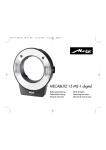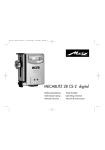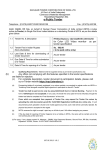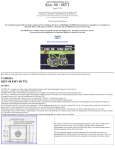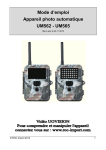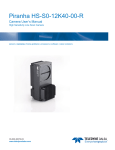Download Metz MS-1 User's Manual
Transcript
708 47 0018.A3 15 MS-1 01.04.2010 9:56 Uhr Seite 1 MECABLITZ 15 MS-1 digital Bedienungsanleitung Gebruiksaanwijzing Manuale istruzioni Mode d’emploi Operating instruction Manual de instrucciones 708 47 0018.A3 15 MS-1 1 2 2.1 2.2 2.3 2.4 2.5 3 4 4.1 ķ 4.2 5 5.1 5.2 6 7 8 9 9.1 10 11 68 01.04.2010 9:56 Uhr Safety instructions . . . . . . . . . . . . . . . . . . .69 Preparation . . . . . . . . . . . . . . . . . . . . . . .70 Power supply . . . . . . . . . . . . . . . . . . . . . .70 Insertion and replacement of batteries . . . . .71 Installation / Deinstallstion . . . . . . . . . . . .71 Switching the flash unit on and off . . . . . . .72 The infrared clamp . . . . . . . . . . . . . . . . . .72 Starting up for the first time . . . . . . . . . . .73 Camera-specific remote operation . . . . . . .73 General information on wireless remote control . . . . . . . . . . . . . . . . . . . . .73 Setting remote channel and remote group . .75 Manual wireless slave mode . . . . . . . . . . .76 Learn function . . . . . . . . . . . . . . . . . . . . . .77 Slave mode . . . . . . . . . . . . . . . . . . . . . . . .79 Operation with synchronous cable . . . . . . .80 Operation of flash unit detached from camera . . . . . . . . . . . . . . . . . . . . . . .81 Lighting OK in remote TTL mode . . . . . . . .81 Swivel reflectors . . . . . . . . . . . . . . . . . . . .81 Bounce diffuser . . . . . . . . . . . . . . . . . . . . .82 The AF auxiliary light . . . . . . . . . . . . . . . .82 Modelling light (ML) . . . . . . . . . . . . . . . . .83 Seite 68 12 Synchronisation on the 1st or 2nd shutter curtain (REAR) . . . . . . . . . . . . . . . . . . . . . .84 13 Slow synchronisation (SLOW) . . . . . . . . . .84 13.1Using a tripod . . . . . . . . . . . . . . . . . . . . . .85 14 Care and maintenance . . . . . . . . . . . . . . .85 14.1Firmware update . . . . . . . . . . . . . . . . . . . .85 14.2 Reset . . . . . . . . . . . . . . . . . . . . . . . . . . . .85 14.3Conditioning the flash capacitor . . . . . . . . .86 15 Troubleshooting . . . . . . . . . . . . . . . . . . . .86 16 Technical data . . . . . . . . . . . . . . . . . . . . . .86 Diagram . . . . . . . . . . . . . . . . . . . . .134-137 Introduction Thank you for choosing a Metz product. We are delighted that you have become a Metz customer. Of course you can hardly wait to use your flash unit. It is worthwhile to read the operating manual as it is only in this way you can learn how to use the device without difficulties. ☞ Please refer to the back cover at the end of the manual. 708 47 0018.A3 15 MS-1 01.04.2010 1 Safety instructions • The flash unit is exclusively designed and authorised for use in photographic applications. • Do not flash directly into eyes from a close distance! Direct flashing into the eyes of persons or animals can cause damage to the retina and severe disruption of the vision – up to and including permanent blindness! • The flash unit may in no event be activated in the vicinity of inflammable gases or liquids (petroleum, solvents etc.). RISK OF EXPLOSIONS! • Never use a flash unit to photograph car, bus, bicycle, motorbike or train drivers while they are driving. Blinding the driver can lead to an accident! • Only use the power sources designated and authorised in the operating manual. • Do not open the batteries or short them! • In no event the batteries be exposed to high temperatures like direct sun- 9:56 Uhr Seite 69 light, fire or similar! • Remove the used batteries immediately from the device! Chemicals can escape from used batteries (so-called “leaks”) resulting in damage to the device! • Batteries may not be recharged! • Do not expose the flash unit to water drops and splashes! • Protect your flash unit from heat and high air humidity! Do not keep it in the glove compartment of your car. • After repeated flashing, do not touch the diffuser. Risk of burns! • After a series of flashes with full power and short intervals, a pause of at least 3 minutes must be observed after each series of 20 flashes! • When you activate the flash, there should be no opaque material directly in front of or on the reflector cover (flash window). The intense energy emissions can otherwise lead to scorching or spotting of the material and/or the reflector cover. Do not dismantle the flash unit! HIGH VOLTAGE! ķ 69 708 47 0018.A3 15 MS-1 01.04.2010 9:56 Uhr Seite 70 2 Preparation Repairs should only be performed by authorised service personnel. • Do not touch the electrical contacts of the flash unit. • If the housing has been damaged in such a way that internal components are exposed, the flash unit may no longer be used. Remove the batteries! Do not touch any internal components. HIGH VOLTAGE! • Do not use any toxic batteries or rechargeable batteries! 2.1 Power supply The flash unit can optionally be operated with: • 2 alkali-manganese dry batteries Type IEC LR03 (AAA / Micro), maintenance-free power source for moderate power requirements. • 2 NC batteries Type IEC KR03 (AAA / Micro). • 2 nickel metal hydride batteries Type IEC HR03 (AAA / Micro), significantly higher capacity than NC batteries and less harmful to the environment than the NC batteries as they are cadmium-free. They offer very short flash sequence times and economical operation as they are rechargeable. • 2 lithium batteries 1.5 V, Type IEC FR03 (AAA / Micro), maintenancefree power source with high capacity and low self-discharge rate. ķ ☞ 70 The batteries/rechargeable batteries are empty or used if the flash interval for flashes at full power rises 708 47 0018.A3 15 MS-1 01.04.2010 9:56 Uhr • Close battery compartment cover and slide against the housing. above 60 seconds. If you do not use the flash unit for a prolonged period, you should remove the batteries from the unit. 2.3 Installation /Deinstallation Carefully screw an adapter ring of the appropriate size into the filter thread of the objective. 2.2 Insertion and replacement of batteries • Turn off the flash unit via the main switch . • Slide the battery compartment cover at the bottom of the flash unit and fold it open. • Insert the batteries in the accordance with the symbols on the inside of the battery compartment cover. When inserting batteries, ensure that the polarity is correct and matches the symbols in the battery compartment. Inserting the batteries in the wrong direction can destroy the flash unit! Always replace all batteries simultaneously, and make sure that batteries are the same brand and have the same capacity. Flat or dead batteries should not be disposed of with ordinary household waste. Help protect the environment, and dispose of flat/dead batteries at the appropriate collection points. Seite 71 ☞ Recommendation: Only use internal focusing objectives! Note, with external focusing objectives you must perform the focusing manually. The risk of damage to the flash unit due to the weight of the objective or of the adjusting motor cannot be ruled out. Press both the release buttons on the flash unit, keep them pressed, and at the same time insert the flash unit up to the stopper on the adapter ring of the objective. When the release buttons are released, the flash unit is held on the adapter ring by four snap-in clips. ☞ Make sure that the flash unit is securely locked in place on the adapter ring. When the camera and the flash unit are combined, always hold the combination by the camera and never by the flash unit. ☞ ķ 71 708 47 0018.A3 15 MS-1 01.04.2010 9:56 Uhr The flash unit can be rotated (turned) on the adapter ring. Removal Press both the release buttons on the flash unit, keep them pressed, and at the same time carefully pull the flash unit off the adapter ring of the objective. 2.4 Switching the flash unit on and off To switch-on, move the main switch to the “ON” position. To switch-off, move the main switch to the left. ☞ ķ 72 If the flash unit is not required for a longer period of time, it should always be switched off by the main switch and the batteries/rechargeable batteries should be removed from the flash unit! Seite 72 2.5 The infrared clamp The camera’s own flash unit and the use of mecablitz 15MS-1 digital should not contribute to the lighting of macropictures, so that no shadows are caused by the housing of mecablitz 15MS-1 digital. The camera’s own flash light can be covered with the infrared clamp. The infrared clamp allows the control impulses through, but holds back the flash light, which contributes to the lighting. Installation of the infrared clamp Open the infrared clamp with your fingers and slip it over the camera’s own flash unit. Slide down the infrared clamp with rubber lips as far as possible over the camera’s own flash unit and close it. 708 47 0018.A3 15 MS-1 01.04.2010 9:56 Uhr Seite 73 3 Starting up for the first time 4 Camera-specific remote operation When the flash unit is switched on for the first time or when a “RESET” is performed (see Chapterir 14.2), the following display appears after the main switch is activated: This remote operating mode is only possible if the camera supports remote operation with an integrated flash or if an additional flash unit is mounted on the camera (e.g. Metz mecablitz 58AF-1) which supports remote operation. • Press the button S E L on the flash unit. In the display appears: • Now set the desired operating mode: - The camera specific remote control (see Chapter 4) - Manual wireless slave mode (see Chapter 5) - Learn function (see Chapter 5.1) - Slave mode (see Chapter 5.2) - Operation with a synchronous cable (see Chapter 6) 15MS-1 V1.0 SELECT SEL 4.1 General information on wireless remote control A remote system consists of a master or controller flash unit in the camera or an external master or controller flash unit on the camera and one or more slave flash units. The slave flash unit is remotely controlled by the master or controller flash unit. A master flash unit contributes to the lighting and at the same time controls the slave flash units. A controller flash unit only has control functions. The slave flash unit is assigned to one of three possible groups (A, B or C – ķ 73 708 47 0018.A3 15 MS-1 01.04.2010 9:56 Uhr only with Canon, Nikon, Olympus). Each group can in turn consists of one or more slave flash units. Four independent remote channels (Channels 1-4) are available, so that several remote systems in the same space do not cause mutual disruption. The setting “Channel ALL” controls all slave flash units. Slave flash units that belong to the same remote system must be set to the same remote channel. The slave flash units must be able to pick up the light from the master or controller flash unit via integrated sensors for remote operation . Adjustment of the flash unit ķ • Switch the flash units integrated in the camera or external flash unit on the camera in the Master or Controller mode, see operating manual of the camera or external flash unit. • Select an operating mode on the camera that supports remote operation 74 Seite 74 • Slide the infrared clamp over the camera’s own flash unit if it is to be used as controller flash unit. Swivel the external flash unit so that it cannot contribute to lighting. 15MS-1 V1.0 • Switch-on the flash unit with the main switch . • Keep the button “AF/SELECT” pressed down until the following message appears in the display: ⊃ SELECT SEL MODELLING LIGHT OFF ON SEL OK SYSTEM NIK REMOTE Ch ALL Gr A S E L OK SYSTEM OLY REMOTE Ch ALL Gr A S E L OK • Press the button S E L on the flash unit. In the display appears: • Switch-on (ON) the “MODELLING LIGHT” function with the button or switch it off (OFF). • Press the button S E L on the flash unit. The most recently used setting appears in the display, e.g.: • Press the button until the required version for the camera type used appears in the display: „CAN REMOTE“ (Canon) or „NIK REMOTE“ (Nikon) or „OLY REMOTE“ (Olympus) or 708 47 0018.A3 15 MS-1 01.04.2010 9:56 Uhr Seite 75 „PEN REMOTE“ (Pentax) or „SAM REMOTE“ (Samsung) or „SON REMOTE“ (Sony) • Press the OK button, thus the selected remote mode is set, in the example “OLY REMOTE” (Olympus). The ratio of the reflectors is 1:1. Group A (only with CAN, NIK and OLY) is automatically set if another group has not been selected for a previous application. • If the two reflectors should be set at an unequal ratio (Ratio) then press the button or to change the ratio of both the reflectors. GrA OLY 1:1 GrA OLY 8:1 The setting thus made will be automatically saved. In the operating modes “CAN REMOTE” or “NIK REMOTE” and/or “OLY REMOTE”, various slave channels and various slave groups can be set when several slave flash units are used (see Chapter 4.2). In the operating modes “PEN REMOTE” and/or “SAM REMOTE” and/or “SON REMOTE”, only different slave ☞ ☞ channels can be set when several slave flash units are used (see Chapter 4.2 and operating manual of the camera). The flash unit supports the wireless Sony remote system in the “CTRL” and “CTRL + ” modes, depending on the camera system used. The “CTRL” and “CTRL + ” modes are automatically detected. The slave flash units always work in the “RMT” group. The set-up can always be checked by pressing the “AEL” key on the camera. The slave flash unit must respond with a timedelayed flash. 4.2 Setting remote channel and remote group ķ Four independent remote channels (CHANNELS 1 to 4) are available, so that several remote systems in the same space does not cause mutual disruption Master and/or controller and slave flash units that belong to the same remote system must be set to the same remote channel. In the case of Sony and Pentax cameras “CHANNEL ALL” must be ☞ 75 708 47 0018.A3 15 MS-1 ☞ 01.04.2010 9:56 Uhr set if a fixed channel is not used in the remote system. In the case of “CHANNEL ALL”, all set channels are activated. In the remote operating modes, groups can be set in addition to the channels (CHANNEL) in order to control the desired slave flash unit of a specific group. The setting of groups (GROUP A, B, C) is only possible in Canon, Nikon and Olympus remote control modes. Setting a channel (CHANNEL) and a group (GROUP) in a camera-specific remote system ķ • Keep the button “AF/SELECT” SELECT pressed on the flash unit until the following message appears in the SEL ⊃ display: MODELLING LIGHT OFF ON SEL OK SYSTEM OLY REMOTE Ch ALL Gr A S E L OK 76 • Press the button S E L on the flash unit. In the display appears:: • Press the button S E L on the flash unit. The most recently used setting appears in the display, e.g.: Seite 76 CHANNEL ALL SEL CHANNEL 3 SEL SEL • Press button and select the desired group (GROUP A, GROUP B, GROUP C). GROUP A SEL SYSTEM OLY REMOTE Ch 3 Gr A S E L OK OLY Ch3 GrA 1:1 • Press button and select the desired channel (CHANNEL ALL – CHANNEL 1..4). • Press button S E L , the selected remote channel is set. In the display appears: GROUP A • Press the button S E L on the flash unit. In the display appears: • Press button group is set. SEL and the desired • Press button OK , the selected remote channel and remote group are set. 5 Manual wireless slave mode Even when cameras are used without a camera-specific remote system, wireless release of one or more slave flash units is possible. 708 47 0018.A3 15 MS-1 01.04.2010 Several digital cameras fire one or more measuring pre-flashes and/or flashes for a fraction of a second before the picture is taken in order to reduce the „red-eye effect“. The measuring pre-flashes cannot usually be deactivated on the camera. When starting up the camera for the first time, changing the camera or RESET, select the “Learn function” (see Chapter 5.1). If the “Learn function” has already been operated once and you continue to use the same camera, select the “Slave mode” (see 5.2). 5.1 Learn function The “Learn function” enables individual automatic adjustment of the slave flash unit to the flash technology of the camera’s flash unit. In the process, one or more pre-flashes, e.g. to reduce the “red-eye effect” of the camera flash unit can be taken into account. The slave flash unit is then fired to coincide with the main flash that illuminates the actual picture. 9:56 Uhr Seite 77 ☞ If the camera’s own flash device provides for automatic focussing AF measuring flashes, then due to the system characteristics no learn operation is possible. If possible, use another camera mode or change to manual focussing. Adjustment of the flash unit • Activate camera flash unit. If required, activate the pre-flash function on the camera to reduce the “red-eye effect”. • Slide infrared clamp over the camera’s own flash unit, if it is to be used as controller flash unit. Swivel external flash unit so that it cannot contribute to lighting. • Switch-on the flash unit with the main switch . ķ 15MS-1 • Keep the button “AF/SELECT” pressed until the following message appears in the display: • Press the button S E L on the flash unit. In the display appears: V1.0 SELECT SEL ⊃ MODELLING LIGHT OFF ON SEL OK 77 708 47 0018.A3 15 MS-1 SYSTEM NIK REMOTE Ch ALL Gr A S E L OK SYSTEM S L AV E SEL LEARN NO NO YES SEL LEARN OK OK YES SEL OK 01.04.2010 9:56 Uhr • Press the button S E L on the flash unit. The most recently used setting appears in the display, e.g.: • Press the button until “SYSTEM SLAVE” appears in the display. LEARN 78 OK SL P/R SL Ratio 4:1 • Switch-on (YES) the “LEARN” function with the button. SL • Press the release button on the camera so that the camera’s own flash unit is activated. If a light impulse has been received by the mecablitz 15MS-1 digital, the bar display stops filling. In the display, “LEARN OK” appears and a red light in the „AF-/SELECT“ button lights up briefly as confirmation. Ratio 1:1 • Press button S E L drücken. In the display appears: • Press OK button. In the display TA K E A PICTURE appears: The flash unit waits for a flash light ⊃ from the camera’s own flash unit. The bar display continually fills as long as no light impulse is received from the camera’s own flash unit. ķ Seite 78 P/R Power 1/1 SL P/R Power 1/4 P/R The mecablitz 15MS-1 digital has now learnt to recognise the flash light of the camera flash unit. In the display appears: • If both the reflectors should be set to an unequal ratio (Ratio) then press the button or to change the ratio of both the reflectors. • If you wish to use partial lighting, then press the button P / R Following display appears: • To set partial lighting, press the buttons or and thus change the value. In the display appears, for example. The setting thus made will be automatically saved ☞ If the “Learn function” has already been operated once, these settings are retained until the learn function is used for the next time. ☞ If the setting to reduce the “red-eye effect” is changed, the learn function must be repeated. 708 47 0018.A3 15 MS-1 01.04.2010 9:56 Uhr Seite 79 5.2 Slave mode • Press the button S E L on the flash unit. The most recently used setting appears in the display, e.g.: “Slave mode” reflects the setting that has been learnt in the “Learn function”. This function is retained until a “Learn function” or a “RESET” is performed again. • Press the button until “SYSTEM SLAVE” appears in the display. • Press the OK button and the SLAVE mode is set with a ratio of 1:1 between both the reflectors and full lighting power (Power) 1/1. Following display appears: Adjustment of the flash unit • Activate the camera flash unit. • Slide the infrared clamp over the camera’s own flash unit if it is to be used as controller flash unit. Swivel external flash unit so that it cannot contribute to lighting. • Switch-on flash unit with the main switch . • If both reflectors should be set at an unequal ratio (Ratio) then press the button or to change the ratio. The ratio can be adjusted in steps. In the display appears, for example 15MS-1 • Keep the button “AF/SELECT” on the flash unit pressed until the following message appears in the display: SEL • Press the button on the flash unit. In the display appears: V1.0 • If you wish to use partial lighting, then press the button P / R . Following display appears: SYSTEM NIK REMOTE Ch ALL Gr A S E L OK SYSTEM S L AV E SEL SL OK Ratio 1:1 P/R SL Ratio 4:1 SL P/R Power 1/1 P/R SELECT SEL ⊃ MODELLING LIGHT OFF ON SEL OK • To set partial lighting, press the buttons or and thus change the value. In the display appears, for example. SL Power 1/4 P/R The setting thus made will be automatically saved. 79 ķ 708 47 0018.A3 15 MS-1 ☞ 01.04.2010 9:56 Uhr For Remote Control mode , the slave flash unit must be able to register the light from the camera flash unit immediately and without restriction so that it is fired! The operating range of the arrangement depends on the intensity of the light impulse of the camera flash unit, the reflection characteristics of the object and ambient lighting. Please note that the operating range is reduced outside and when the ambient light is bright. Avoid exposing the flash unit light sensors to direct sunlight! Seite 80 Adjustment of the flash unit • Select a manual operating mode on the camera. 15MS-1 • Keep the button “AF/SELECT” on the flash unit pressed until the following message appears in the ⊃ display: SELECT SEL MODELLING LIGHT OFF ON SEL SYSTEM ķ V1.0 OK 6 Operation with synchronous cable S L AV E The flash unit can be operated with a synchronous cable 15-50. For this, connect the synchronous socket of the camera with the synchronous socket of the flash unit. SYSTEM SYNC-CORD SEL OK OK SYNC R atio 1:1 80 • Switch-on flash unit with the main switch . P/R • Press the button S E L on the flash unit. In the display appears: • Press the button S E L on the flash unit. The most recently used setting appears in the display, e.g.: • Press the button suntil “SYNC-CORD” appears in the display. • Press the OK button and the “SYNC-CORD“ mode is set with a ratio of 1:1 between both the reflectors and full lighting power (Power) 1/1. The following display appears: 708 47 0018.A3 15 MS-1 01.04.2010 • If both the reflectors should be set at an unequal ratio (Ratio) then press the buttons to change the ratio. The ratio can be adjusted in steps. In the display appears, for example. • If you wish to use partial lighting, then press the button P / R . Following display appears: • To set partial lighting, press the buttons or and thus change the value. In the display appears, for example. The setting thus made will be automatically saved. 7 Operation of flash unit detached from camera The flash unit can be detached from the camera and setup on the base unit or can be fixed to a tripod with the tripod thread . For detached setup, please ensure that the sensors for remote operation can receive the light from the camera flash unit. 9:56 Uhr Seite 81 8 Lighting OK in remote TTL mode SYNC R atio 1:8 P/R SL Power 1/1 P/R SYNC P ower 1/4 P/R In camera-specific remote–TTL mode, the button “AF/SELECT” also serves as lighting OK display. If the object has been sufficiently illuminated, then the red “AF/SELECT” button lights up for approx. 3 seconds. If the object has been over illuminated, then the red “AF/SELECT” button blinks for approx. 3 seconds. Change the ISO setting or the aperture and try the illumination again. If the object has been insufficiently illuminated, then the red “AF/SELECT” button does not light up. Change the ISO setting or the aperture and try the illumination again. ķ 9 Swivel reflectors Both the reflectors can be swivelled by 10° and 20°. To swivel the reflectors, press the reflector swivel lever forwards in steps. In the first indexed position, the reflector is swivelled 81 708 47 0018.A3 15 MS-1 01.04.2010 9:56 Uhr Seite 82 inwards by 10°, at the second position by 20°. ☞ The working distance is the distance between the object and the front edge of the flash unit. As a guideline, we recommend : • Working distance of approx. 2-10cm: Swivel reflectors by 20° and set the bounce diffuser (see 9.1) in front of reflectors. At distances over 10 cm, the reflectors can be swivelled to a greater or lesser extent to achieve a centre weighted average or a balanced illumination. ķ 9.1 Bounce diffuser The bounce diffuser is required for illuminating the objects in close proximity at distances less than 10 cm. Installation of bounce diffuser Position the bounce diffuser asymmetrically over the flash unit so that the reflectors and the AF auxiliary light are covered. Press the bounce diffuser against the housing of the flash unit until it 82 audibly snaps into place. Turn the bounce diffuser so that the notch of the marking tab aligns with the marking point on the flash unit housing. Removal of bounce diffuser Gently bend up one of the tabs on the bounce diffuser and release it. Take off the bounce diffuser. ☞ Do not lift and remove the bounce diffuser at the marking tab . 10 The AF auxiliary light The flash unit is equipped with an AF auxiliary light which illuminates the object in dark conditions so that the camera can focus clearly on the object or it can be used as illumination for manual focusing. The AF auxiliary light is switched on with button and lights up for around 10 seconds. If a picture is taken, the AF auxiliary light switches off immediately and thus does not contribute to the lighting. 708 47 0018.A3 15 MS-1 01.04.2010 9:56 Uhr Seite 83 11 Modelling Light (ML) • As a confirmation that the “Modelling Light” is switched on, the manual release button blinks. The modelling light (setting light) is a high frequency, stroboscopic flash light. The effect of a quasi continuous light is created for a duration of approx. 2 seconds. The setting light can be used to assess the light distribution and shadow formation before taking a picture. Triggering modelling light Press the manual release button to trigger the modelling light. The modelling light is generated according to the possibly set ratio of the reflectors (Ratio). Activating the modelling light • Switch-on flash unit with the main switch . Deactivating modelling light 15MS-1 • Keep the button “AF/SELECT” pressed until the following message appears in the display: • Press the button S E L on the flash unit. In the display appears: • Switch-on (ON) the “MODELLING LIGHT” function with the button • Press OK button and the “Modelling Light” function is switched to the preset operating mode. V1.0 SELECT SEL ⊃ MODELLING LIGHT OFF ON SEL OK MODELLING LIGHT OFF ON SEL OK ☛ • Keep the button “AF/SELECT” pressed until the following message appears in the display: • Press the button S E L on the flash unit. In the display appears: • Switch-off (OFF) the “MODELLING LIGHT” function with the button . SELECT SEL ⊃ MODELLING LIGHT OFF ON SEL OK MODELLING LIGHT OFF ON SEL OK • Press the button and the modelling light function is deactivated. OK 83 ķ 708 47 0018.A3 15 MS-1 01.04.2010 9:56 Uhr 12 Synchronisation on the 1st or 2nd shutter curtain (REAR) Some cameras support synchronisation with the 2nd shutter curtain (REAR). Thus, the flash unit is not fired until the shutter has closed. This is especially advantageous when lighting with slow shutter speeds (> 1/30s) and moving objects with their own light sources since moving light sources leave behind a trail of light, instead of in the front as with synchronisation on the 1st shutter curtain. This results in a more “natural” reproduction of the situation when the picture was taken for moving light sources. Depending on the operating mode, the camera triggers slower shutter speeds than the flash sync speed. In some cameras, in certain operating modes (e.g. with certain Vari and/or Object programs or with pre-flash function against the “red-eye effect”), REAR operating mode is not possible. The REAR operating mode cannot be selected in this case or is automatical- ķ 84 Seite 84 ly deleted or not performed (see Camera user manual). The REAR operating mode is set on the camera (see Camera user manual). No settings are necessary on the flash unit, nor is there any display for this mode. 13 Slow synchronisation (SLOW) SLOW lighting brings the picture background into stronger focus with weak ambient lighting. This is achieved by the camera shutter speeds that are adjusted to the ambient light. Thus, automatic shutter speeds are automatically triggered that are longer than the flash sync speed (e.g. shutter speeds up to 30s). Slow synchronisation is activated automatically on some camera models in connection with certain camera programs (e.g., a night shot program, etc.), or it can be set on the camera (see the camera’s operating instructions). No settings are necessary on the flash unit, nor is there any display for this mode. 01.04.2010 Slow synchronisation SLOW is set on the camera (see camera’s operating instructions)! Use a tripod when shooting with slow shutter speeds to avoid blurred images! 13.1 Using a tripod The tripod thread of the flash unit may only be used for setting up the flash unit as a slave unit without camera. If the camera has a mecablitz 15MS-1 digital attached to it, only then the tripod thread on the camera may be used to mount it on a tripod. 14 Care and maintenance Remove any dirt and dust with a soft, dry cloth. Do not use any cleaning agents – plastic components could be damaged. 14.1 Firmware update The firmware for the flash unit can be updated via the USB socket and conform to the functions of future cameras (firmware update). 9:56 Uhr ☞ Seite 85 ☞ You can find out more by visiting the Metz homepage: www.metz.de 14.2 Reset The flash unit can be reset to factory settings. Resetting flash unit to factory settings (RESET) • Switch-on the flash unit with the main switch . • Keep the black button on the flash unit on the left pressed until “FACTORY SETTINGS” appears in the display: • Press the button and switch-on (YES) “FACTORY SETTINGS”. • Confirm “FACTORY SETTINGS” by pressing the OK button. The display flashes: The flash unit is reset to the state when it was delivered. • When the flash unit has been reset to the state when it was delivered, the following message appears as confirmation in display: ☛ 708 47 0018.A3 15 MS-1 FA C T O R Y SETTINGS NO YES OK FA C T O R Y SETTINGS NO YES OK RESET SELECT SEL 85 ķ 708 47 0018.A3 15 MS-1 ☞ 01.04.2010 9:56 Uhr This will not affect firmware updates for the flash unit! normally when switched on. If this is not the case, then contact your dealer. 14.3 Conditioning the flash capacitor 16 Technical data The flash capacitor built into the flash unit undergoes a physical change when the device has not been used for a long time. For this reason it is necessary to switch the device every three months for approx. 10 mins. The power supplies must deliver enough power so that flash standby lights up no later than 1 min after switching on. ķ 15 Troubleshooting ☞ 86 Seite 86 If for example, inappropriate messages appear in the display of the flash unit or the flash unit does not operate as it should, switch the flash unit off for approx. 10 seconds with the main switch . Replace the batteries or rechargeable batteries with new batteries or fully recharged batteries! The flash unit should now operate Maximum guide number for ISO 100; 50 mm In metric system: 15 In feet: 49 Manual flash operating modes: Manual flash mode via sync socket Remote flash operating modes: • Canon E-TTL-Remote. • Nikon i-TTL-Remote. • Olympus/Panasonic FourThirds-System TTL Remote. • Pentax/Samsung P–TTL–Remote–System. • Sony-TTL-Remote Slave flash operating modes: • Slave mode with pre-flash suppression via Learn function. 708 47 0018.A3 15 MS-1 01.04.2010 Manual partial lighting: P1/1 to P1/64 Colour temperature: Approx. 5.600 K Synchronisation: Low voltage – IGBT – ignition Flash counts: With NiCd batteries (250 mAh) approx. 50 With high performance alkali-manganese batteries approx. 140 With NiMH rechargeable batteries (1000 mAh) approx. 200 With lithium batteries approx. 250. (at full light power in each case) Recycling times: Depending on the light output: approx. 0.3-5 s. Illumination: 50 mm (small picture format) 9:56 Uhr Seite 87 Swivel ranges and indexed positions of the reflectors: Horizontal: 0° 10° 20° Dimensions in mm (W x H x D): Approx.. 133 x 144 x 38 Weight: Approx. 190 g without power supply Scope of delivery: Flash unit , bounce diffuser, infrared clamp, adapter ring 52mm, adapter ring 55mm, adapter ring 58mm, belt pouch, operating manual. Special accessories: • Adapter ring 15-62 (order no.: 000015622) Adapter ring M62x0,75mm • Adapter ring 15-67 (order no.: 000015673) Adapter ring M67x0,75mm • Adapter ring 15-72 (order no.: 000015673) Adapter ring M72x0,75mm • Synchronkabel 15-50 (order no.: 000015501 ķ 87 708 47 0018.A3 15 MS-1 01.04.2010 9:56 Uhr Battery disposal Germany: As a consumer, you are legally obliged to return used batteries. You will find this symbol on batteries that contain harmful substances: Pb = Battery contains lead Cd = Battery contains cadmium Hg = Battery contains mercury Li = Battery contains lithium ķ 88 Seite 88 Your Metz product was developed and manufactured with high-quality materials and components which can be recycled and/or re-used. This symbol indicates that electrical and electronic equipment must be disposed of separately from normal garbage at the end of its operational lifetime. Please dispose of this product by bringing it to your local collection point or recycling centre for such equipment. This will help to protect the environment in which we all live. 708 47 0018.A3 15 MS-1 Seite 134 SEL oder zuletzt eingestellte Anwendung ou dernière utilisation configurée of de laatst ingestelde toepassing or most recently set application o all’utilizzo impostato per ultimo o último uso configurado SEL ⊃ zurück zur letzten Anwendung Retour à la dernière utilisation Terug naar de laatste toepassing Return to last application Indietro all’ultimo utilizzo volver al último uso ⊃ MODELLING LIGHT OFF ON SYSTEM SYNC-CORD ń SEL OK SEL OK SYSTEM CAN REMOTE N I K REMOTE OLY REMOTE GROUP A A GROUP B SEL OK SEL GROUP C CHANNEL ALL SEL SEL CHANNEL 4 ƴ CHANNEL 1 SEL CHANNEL 3 134 SEL SEL SEL SEL Ch ALL Gr A S E L OK ķ į Diagramm: SYSTEM CANONSYSTEM NIKONSYSTEM OLYMPUS-REMOTE SELECT SELECT 3 Sek. ĸ 9:56 Uhr AF Start ☛ Ķ 01.04.2010 CHANNEL 2 SEL SEL A SEL SYSTEM CAN REMOTE N I K REMOTE OLY REMOTE Ch ALL Gr C S E L OK OK CAN Ch1 GrC N I K Ch1 GrC O L Y Ch1 GrC 1:1 708 47 0018.A3 15 MS-1 01.04.2010 9:56 Uhr Seite 135 Ķ AF Start ☛ SELECT SELECT SEL 3 Sek. SEL oder zuletzt eingestellte Anwendung ou dernière utilisation configurée of de laatst ingestelde toepassing or most recently set application o all’utilizzo impostato per ultimo o último uso configurado ⊃ MODELLING LIGHT OFF ON SYSTEM SYNC-CORD ⊃ SEL zurück zur letzten Anwendung Retour à la dernière utilisation Terug naar de laatste toepassing Return to last application Indietro all’ultimo utilizzo volver al último uso Diagramm: SYSTEM PENTAXSYSTEM SAMSUNGSYSTEM SONY-REMOTE ĸ OK ń SEL OK SYSTEM PEN REMOTE SAM REMOTE SON REMOTE Ch ALL SEL ķ OK SEL CHANNEL ALL SEL CHANNEL 4 SEL SEL SEL CHANNEL 3 SEL ƴ CHANNEL 1 CHANNEL 2 SEL SYSTEM PEN REMOTE SAM REMOTE SON REMOTE Ch ALL SEL OK OK PEN Ch1 SAM Ch1 SON Ch1 1:1 135 į 708 47 0018.A3 15 MS-1 SEL Seite 136 Diagramm: SYSTEM SLAVE + LEARN SELECT SELECT 3 Sek. ĸ 9:56 Uhr AF Start ☛ Ķ 01.04.2010 ⊃ zurück zur letzten Anwendung Retour à la dernière utilisation Terug naar de laatste toepassing Return to last application Indietro all’ultimo utilizzo volver al último uso ⊃ SEL MODELLING LIGHT OFF ON ń SEL OK SEL oder zuletzt eingestellte Anwendung ou dernière utilisation configurée of de laatst ingestelde toepassing or most recently set application o all’utilizzo impostato per ultimo o último uso configurado SYSTEM SYNC-CORD ķ OK S L AV E SEL OK SL į Lernfunktion nur bei Erstinbetriebnahme oder nach Kamerawechsel Fonction d’apprentissage uniquement lors de la première mise en service ou après un changement d’appareil photo Leerfunctie bij eerste ingebruikneming of na een andere camera Learn function only for first time setup or after camera change Funzione di apprendimento solo per la prima messa in funzione o per il cambio della fotocamera Función de aprendizaje únicamente en primera puesta en servicio o tras cambio de cámara 136 P/R R atio 1:1 OK ƴ P ower 1/4 SYSTEM SL P/R P/R P/R SEL LEARN NO YES SEL OK OK SEL klick TA K E A PICTURE ⊃ LEARN OK 708 47 0018.A3 15 MS-1 01.04.2010 9:56 Uhr AF Start ☛ SELECT SEL Ķ Diagramm: SYSTEM SYNC-CORD SELECT 3 Sek. Seite 137 ⊃ zurück zur letzten Anwendung Retour à la dernière utilisation Terug naar de laatste toepassing Return to last application Indietro all’ultimo utilizzo volver al último uso ⊃ SEL ĸ MODELLING LIGHT OFF ON SEL OK ń SEL SYSTEM S L AV E SEL oder zuletzt eingestellte Anwendung ou dernière utilisation configurée of de laatst ingestelde toepassing or most recently set application o all’utilizzo impostato per ultimo o último uso configurado OK ķ SYNCH P ower SYSTEM SYNC-CORD P/R 1/4 OK SYNCH P/R R atio 1:1 OK P/R ƴ P/R 137 į 708 47 0018.A3 15 MS-1 01.04.2010 9:56 Uhr Seite 138 Garantiebestimmungen Bundesrepublik Deutschland 1. Die Garantiebestimmungen gelten ausschließlich für Käufe in der Bundesrepublik Deutschland. 2. Im Ausland gelten die Gewährleistungsregelungen des jeweiligen Landes bzw. die Garantieregelungen des Verkäufers. 3. Die nachfolgenden Bestimmungen haben nur für den privaten Gebrauch Gültigkeit. 4. Die Garantiezeit - 24 Monate - beginnt mit dem Abschluss des Kaufvertrages bzw. mit dem Tag der Auslieferung des Gerätes an den Käufer (Endverbraucher). 5. Garantieansprüche können nur unter Nachweis des Kaufdatums durch Vorlage des vom Verkäufer maschinell erstellten Original-Kaufbeleges geltend gemacht werden. 6. Beanstandete Geräte bitten wir zusammen mit dem Kaufbeleg entweder über den Fachhändler oder direkt an die Firma Metz-Werke GmbH & Co KG Zentralkundendienst - Ohmstrasse 55, 90513 Zirndorf, transportsicher verpackt unter genauer Schilderung der Beanstandung einzusenden. Sie können unter den gleichen Bedingungen auch an die autorisierten Kundendienststellen der Firma Metz-Werke GmbH & Co KG eingesandt werden. Hin- und Rücksendung erfolgen auf Gefahr des Käufers. 7. Die Garantie besteht darin, dass Geräte, die infolge eines anerkannten Fabrikations- oder Materialfehlers 138 defekt geworden sind, kostenlos repariert oder, soweit eine Reparatur unverhältnismäßig ist, ausgetauscht werden. Eine weitergehende Haftung, insbesondere für Schäden, die nicht am Gerät selbst entstanden sind, ist ausgeschlossen. Dies gilt nicht, soweit im Falle des Vorsatzes oder der groben Fahrlässigkeit zwingend gehaftet wird. Garantieleistungen bewirken weder eine Verlängerung der Garantiezeit, noch wird für die ersetzten oder nachgebesserten Teile eine neue Garantiezeit begründet. 8. Unsachgemäße Behandlung und Eingriffe durch den Käufer oder Dritte schließen die Garantieverpflichtungen sowie alle weiteren Ansprüche aus. Ausgenommen von der Garantie sind ferner Schäden oder Fehler, die durch Nichtbeachtung der Gebrauchsanleitung, mechanische Beschädigung, ausgelaufene Batterien oder durch höhere Gewalt, Wasser, Blitz etc. entstanden sind. Ferner sind Verschleiß, Verbrauch sowie übermäßige Nutzung von der Garantie ausgenommen. Hiervon sind vor allem folgende Teile betroffen: Blitzröhre, fest eingebaute Akkus, Kontakte, Verbindungskabel. 9. Durch diese Garantiebestimmungen werden die Gewährleistungsansprüche des Käufers gegenüber dem Verkäufer nicht berührt. Metz-Werke GmbH & Co KG 708 47 0018.A3 15 MS-1 01.04.2010 Hinweis: Ķ Im Rahmen des CE-Zeichens wurde bei der EMV-Prüfung die korrekte Belichtung ausgewertet Remarque: ĸ L’exposition correcte a été évaluée lors des essais de CEM dans le cadre de la certification CE. 9:56 Uhr Seite 139 Opmerking: ń In het kader de CE-markering werd bij de EMV-test de correcte belichting bepaald. Note: ķ Within the framework of the CE approval symbol, correct exposure was evaluated in the course of the electromagnetic compatibility test. Avvertenza: ƴ Nell’ambito delle prove EMV per il segno CE è stata valutata la corretta esposizione. Atención: į El símbolo CE significa una valoración da exposición correcta con la prueba EMV (prueba de tolerancia electromagnética). Technische Änderungen und Irrtümer vorbehalten ! Sous réserve de modifications et d’erreus ! Onder voorbehoudvan wijzigingen en vergissingen ! Errors excepted. Subject to changes ! Riserva di modifiche e disponibilità di fornitura. Con reserva de modificaciones y posibilidades de entrega. 708 47 0018.A3 15 MS-1 01.04.2010 9:56 Uhr Seite 140 Metz - Werke GmbH & Co KG • Postfach 1267 • D-90506 Zirndorf • [email protected] • www.metz.de Consumer electronics Photoelectronics Plastics technology 708 47 0018.A3 Metz - always first class. Ķĸńķƴį





























